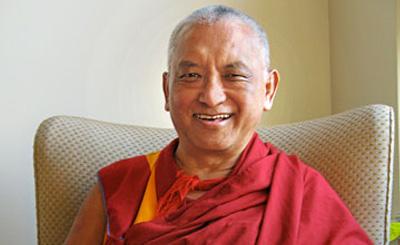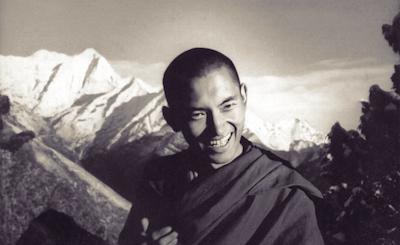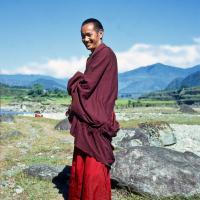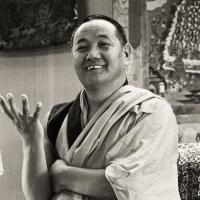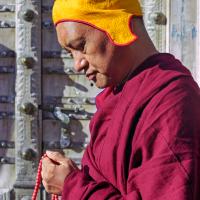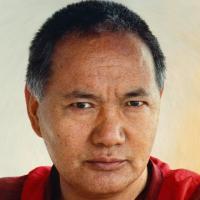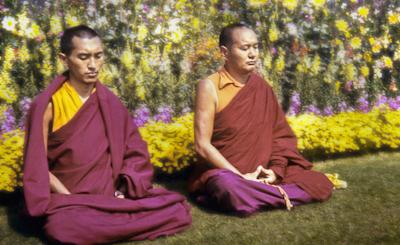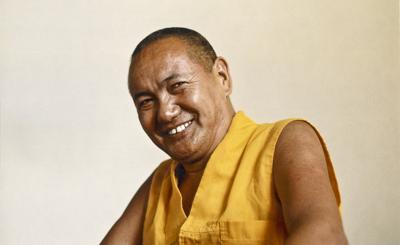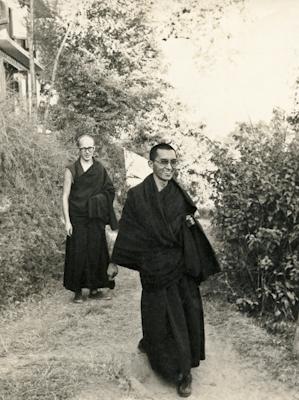Our aim is to quickly enlighten sentient beings, bringing them to the highest blissful state. Quickly attaining this aim depends on our quickly achieving enlightenment. So, if we wish to achieve enlightenment quickly, we should quickly experience bodhicitta. We should put our main effort into the practice of bodhicitta.
In order to quickly actualize bodhicitta it is necessary to depend on a special deity, such as the Compassion Buddha, the Great Compassionate One, Avalokiteshvara, and the way of meditating on this deity is by looking at Avalokiteshvara as oneness with our own guru. This is the way to quickly receive blessings and fertilize the hard, solid mind; in other words, in order to grow bodhicitta, we need to fertilize and ripen our thick, hard mind.
The benefits of making a statue of Avalokiteshvara are the same as making statues of all the buddhas. It has great benefits. And if we meditate on Avalokiteshvara, the benefit is that of having meditated on all the buddhas. It has that much benefit. Making a painting or statue of Avalokiteshvara has the same benefit as making paintings or statues of all the buddhas and bodhisattvas, and it’s the same for meditating on Avalokiteshvara.
Guru Shakyamuni Buddha said in a sutra, “Even in each pore of Avalokiteshvara’s holy body, there are numberless buddhas and their pure fields.”
When we meditate on or prostrate to Avalokiteshvara, the Compassion Buddha, it is very effective to remember that Avalokiteshvara is the embodiment of all the buddhas, and to also remember that in each pore of Avalokiteshvara, there are numberless buddhas in the pure fields. Thinking in this way helps to stop the wrong conception of Avalokiteshvara as a buddha completely separate from Guru Shakyamuni Buddha, Tara, and all the other aspects of buddha, just as we think we sentient beings are mentally and physically separate from each other. We shouldn’t have the same superstition about the buddhas. Meditating in this way stops the superstition that discriminates like that. It is not that Avalokiteshvara has nothing to do with Guru Shakyamuni Buddha, nothing to do with Manjushri, nothing to do with Tara.
When you think of or meditate on Avalokiteshvara, you are thinking of all the buddhas. Avalokiteshvara is an embodiment of all the buddhas. In each pore of Avalokiteshvara’s holy body there are all the buddhas of the three times and their pure fields. When you think of that, you are thinking of something totally different. Take this metal mug, for example. So many atoms are gathered together to appear in this shape, which is then called a mug. When you meditate in this way on Avalokiteshvara, you are thinking of all the buddhas.
Even each pore of Avalokiteshvara works for all sentient beings, by showing innumerable different manifestations, as I explained last night. Also, the thousand arms transform into the thousand wheel-turning kings, who are working for sentient beings. They give teachings, and they make charity to those who can be subdued by making charity. They show many different methods. And the thousand eyes transform into the thousand buddhas. Like this, Avalokiteshvara is working for other sentient beings in many realms.
Also, making offering to Avalokiteshvara has the same benefit as making offering to all the buddhas. Prostrating while repeating the holy name of Avalokiteshvara has the same benefit as prostrating to and repeating the names of all the buddhas. So, it has great benefit. Even by repeating Avalokiteshvara’s name, you get the same benefit as by repeating all the buddhas’ names.
There is a long mantra and a short mantra of Avalokiteshvara. When you recite the long mantra, which starts with NAMO RATNA TRA YA YA..., many times, you can shorten it by reciting from TADYATHA OM DHARA DHARA.... When you do an Avalokiteshvara retreat that has an offering burning puja at the end, you recite the short mantra 600,000 times or the long one 40,000 times. When you are counting the 40,000 long mantras, you can count them by reciting just TADYATHA OM DHARA DHARA...ILI MILI CHITI JALA APANAYE SVAHA. Reciting only this last part of the long mantra is like having recited the short mantra, OM MANI PADME HUM 600,000 times. This was explained by my kind guru Tsenshap Serkong Rinpoche, whom you saw just before we left. So, the long mantra equals many of the short mantras.
As you have met Tsenshap Serkong Rinpoche, maybe I will just mention something about him. Most of you will have heard or read about Marpa, Milarepa’s guru. I’m not sure whether Marpa’s biography has been translated into English. It isn’t well-spread like the biography of Milarepa.
There are actually two Serkong Dorje Changs in Kathmandu.1 There is the one we have seen, who gave teachings to us, and there is another Serkong Dorje Chang at Swayambunath, which people call the “Monkey Temple.” The previous incarnation of the one at Swayambunath was the father of the Serkong Rinpoche who gave teachings to us. I don’t think you have seen the other lama at Swayambunath. In his previous life that Serkong Dorje Chang was a very highly realized married lama, who had reached the point of the realization of immortality through the tantric path. He was completely free from the danger of death and all those things. In his previous life he was a married lama, and the Serkong Rinpoche who gave teachings to us is the son of that Serkong Dorje Chang.
In his previous life, Serkong Dorje Chang had three disciples in Tibet who achieved enlightenment in one life through accomplishing a specific buddha of wisdom called Purifying Wisdom.
Serkong Dorje Chang is actually the embodiment of Marpa, Milarepa’s guru, who made it possible for Milarepa, who had done black magic and created much negative karma, to achieve enlightenment in one life. In other words, the Serkong Dorje Chang at Swayambhunath is Marpa. How we see Marpa these days is in that form.
Then, the Serkong Dorje Chang who gave teachings to us is the embodiment of the great yogi Marpa’s son, called Darma Dodé. There are a lot of stories about this son in the biography of the great Marpa. With his tantric realizations, he left his body and took the form of a bird. He then flew from Tibet to Bodhgaya, in India, to the great cemetery of [Sil wä tsäl], one of Mahakala’s holy places. He saw there a human corpse, brought there that day, so he left the body of the bird and his consciousness entered that corpse. The corpse became alive, and then went back to the family of the corpse. From his presence and his actions, the family felt that the person was not their son but some holy person. There are many stories about the transferring of one person’s consciousness into a dead body.
Anyway, this technique started from Marpa, the lineage came from Marpa. Many of his followers had practiced it, transferring the consciousness of others and their own. Afterwards, the king of Tibet thought the practice should not be spread widely, because it could be very dangerous if some people used it in the wrong way, for black magic rather than for Dharma reasons. The Tibetan king made a law to stop the spread of the technique. However, there is no need to talk much about that part.
There is also an incarnate lama who is the embodiment of Milarepa. I have heard that the other Serkong Dorje Chang, the one at Swayambhunath, is an incredible yogi, a great hidden yogi. Hidden means that he always pretends he knows nothing about Dharma.
I will tell you the story of the first time that I met him. I wanted to see him very, very much from when I was in India, because I had heard stories about him. So when I went to Nepal, one day Lama Yeshe and I, as well as Zina, our first Western student, and an English boy called Clive went to see him. At that time he didn’t live at the monastery but in a house near the stupa at the top of Swayambhunath. When we found the house, there was a very simple monk coming down the steps. When I asked him, “Can I see Serkong Dorje Chang,” he said, “Not yet.” He said that there would be no interview for some time.
I think he then went to pee, then later came back and went upstairs. When we went upstairs to see Serkong Dorje Chang, it turned out to be the monk who said there would be no interview with Serkong Dorje Chang for some time. He was Serkong Dorje Chang.
We then went in to see him. I think it must have been quite a special occasion, because it was the first time we saw him, and he said a few powerful words on guru devotion practice. The few words he said were incredible. However, my mind was so obscured that I couldn’t follow some of the words.
Zina, because it was natural for her as she was from the West and not like a normal Tibetan person, then asked Rinpoche, “Could you read something?”
If you asked Dharma questions, he usually showed the aspect of not understanding.
During the day Serkong Dorje Chang would often come to circumambulate the stupa. Sometimes, when it was the right time, when he met a certain person near the stupa, he would suddenly tell them, “You are going to die in two years, so you must do prostrations.” Exactly two years later, they would hear that that person had died.
Many people came to ask him to make observations for them. He would sometimes tell certain people such things, even if they didn’t ask him. Sometimes a Tibetan who had been in the army and killed people would come to ask for an observation. The manager would bring the person up to Rinpoche’s room and the person would ask a question about his business or some other question. Before throwing the dice to make the observation, Rinpoche would tell him, “Oh, you have killed a human being, so you should make 700,000 prostrations by reciting the names of the Thirty-five Buddhas.” Rinpoche could clearly see the whole life of the person, everything he had done, just like watching a movie.
The other person would be shocked, because he wasn’t expecting the mistakes he had made to be exposed. Unable to ask another question, he would just leave quietly. Similar things happened many times.
Rinpoche could clearly see past things, even the dreams a person had had. That is my personal experience. I used to go to see him quite often, when I had time and the opportunity. One time when I went to see him, he mentioned the dreams that I had had. Also, he doesn’t need to throw dice or use a mala or anything else to make observations. He understands clearly, but he acts as if he doesn’t understand very well. You can feel that he can see clearly. He already has the answer in his mind before he touches the dice. You can feel it when you look at his face. He sometimes starts to give the answer before he throws the dice.
If you ask a Dharma question, he pretends that he doesn’t know anything. Perhaps at certain times to a certain person, someone very fortunate with thin obscurations, he might explain Dharma.
For the past two or three years Rinpoche has shown the aspect of having epilepsy. Sometimes when he goes to do a puja in the home of a Tibetan family or when he’s giving an interview to a lot of people, he suddenly falls down from the bed and his arms and legs shake. With a normal person, you might believe he was actually sick because of the way he acts.
On certain days, the monastery had to do very important wrathful pujas for the Tibetan government, for independence and many other things. In a wrathful puja, Vajrayana meditation is used to try to control and subdue the spirits, the evil-doers, who disturb the teachings and Dharma practice. It involves making big offering cakes and throwing them in big fires outside. It also involves a lot of Vajrayana meditation. The lama who leads the puja and throws the offering cakes and does the actions to control and subdue the spirits has to have good understanding, concentration, and power. It cannot be done by just any ordinary person as it can be very dangerous for their life.
On the important days when they had to do such pujas, the monks would request Rinpoche, “Please don’t get sick today.” Rinpoche would accept their request by saying, “Yes, of course. If I can’t do that, how can I be called Serkong Dorje Chang?”
On the important days, he doesn’t get sick. That shows that he has complete freedom, that he is not actually sick. An ordinary person has no choice about when they get sick. They can’t choose to get sick or not to get sick on particular days. There are many amazing stories of Rinpoche’s life.
Also, he usually sees and communicates with Tara and other deities. He himself is the deity, the actual Vajradhara, Yamantaka, Heruka, so there is no doubt that he can see other deities.
The Serkong Rinpoche who came to Kopan is the son and disciple of the previous incarnation of the Serkong Dorje Chang at Swayambunath, but their present relationship is that Tsenshap Serkong Rinpoche is the teacher of Serkong Dorje Chang, his past-life father. He taught him the alphabet in Tibet. In Tibet, Serkong Dorje Chang had to give a Kalachakra initiation. This initiation is given only by His Holiness the Dalai Lama, the Panchen Lama, who is in Tibet, and certain other lamas. It is not given by common lamas.
One learned geshe from one of the monasteries requested the initiation, and many people came from all over Tibet to receive the Kalachakra initiation from Serkong Dorje Chang.
The night before the initiation was to be given, Tsenshap Serkong Rinpoche had to instruct Serkong Dorje Chang how to explain to people the eight freedoms and ten richnesses as the preliminary to the initiation. He briefly explained how to do this as the motivation. Tsenshap Serkong Rinpoche was very worried about how Serkong Dorje Chang was going to teach the people. Rinpoche himself told me this story.
The next day he started to explain the eight freedoms and ten richnesses, but when he got to the part of the long-life god, he mentioned instead the long-life man. You might have seen the long-life man on the postcard; he has a long beard and wrinkles and is surrounded by a deer, a stork, and other symbols of long life. There are five symbols of long life: water, a tree, a deer, a man, and a stork. They are auspicious for long life.
So, Serkong Dorje Chang used the example of the long-life man instead of the long-life gods. After he said that, one learned geshe who had come to take the initiation left. This geshe, of course, had studied all the different aspects of Dharma. Somehow he didn’t understand and didn’t recognize Rinpoche’s qualities. In the middle of the teaching, he just gave up and left, but other people stayed. Perhaps the geshe thought that if Rinpoche didn’t even know the eight freedoms, how was he going to give the initiation. The geshe didn’t recognize what Rinpoche actually is. Afterward, when Rinpoche reached the part of explaining the tantric initiations, he explained the most difficult parts in a very profound and detailed way. Tsenshap Serkong Rinpoche told me that Serkong Dorje Chang sometimes does strange things like this.
Serkong Dorje Chang also sleeps only one or two hours at night, though he’s not actually sleeping the way we sleep. He lies down on his bed for two hours, then he gets up at about one o’clock. He does this all the time, every night. It is the same with Tsenshap Serkong Rinpoche, who came to Kopan. He also sleeps only two hours. They look like they are sleeping, but they do retreat in the mornings, from one o’clock. Both Rinpoches always do this, wherever they are. They do things that an ordinary person would find very difficult to imitate.
At certain times, when there are not many people around, Serkong Dorje Chang tells stories of his previous lives. One day he and Thubten Gelek, a monk who lives at his monastery, were walking back together from a house where they had done a puja. There were no other monks around, and Serkong Dorje Chang stopped in the road and suddenly said, “Actually, I am Marpa.”
Tsenshap Serkong Rinpoche is not an actual teacher of His Holiness the Dalai Lama but he helps His Holiness in debating and Dharma discussions. He gives answers to His Holiness’s questions, or he asks His Holiness questions and debates with him. However, these days Rinpoche is also one of His Holiness’s teachers. Tsenshap Serkong Rinpoche is Marpa’s son, Darma Dodé. There is also a young incarnate lama who is Milarepa.
When there are not many people around and it is the right time, Serkong Dorje Chang mentions such things.
I heard one story from Tsenshap Serkong Rinpoche’s servants about their escape from Tibet to India. Tsenshap Serkong Rinpoche visited Serkong Dorje Chang in this monastery and brought him with him when he escaped. Along the way they stopped at to a place called Lhodrak, where Milarepa had built the nine-story stone tower. There were Chinese all around them. When they tried to go one way, the Chinese came; when they tried to go another way, the Chinese came. They were in a difficult spot.
Upstairs, on the very top floor of the nine-story tower, there were statues of Marpa and of his consort, or secret mother. There were also many natural handprints that Milarepa had left inside the tower. There were many other servants and monks with them. Tsenshap Serkong Rinpoche asked his older attendant, [Chenza-la], to take a short walk with him. They went into the tower and up to the very top floor where the statues were. At that time, they were in a difficult situation, with Chinese all around them.
Rinpoche always kept on his body a damaru and a rosary. The damaru had belonged to Marpa and the rosary had belonged to Marpa’s consort. Actually, in his previous life, Serkong Dorje Chang was a married lama, and his wife, Tsenshap Serkong Rinpoche’s mother, was Marpa’s consort.
So, it was a very difficult time, with the Chinese all around and no way to get out. They were expecting the Chinese to reach that place soon. Rinpoche took one servant upstairs to the top floor. Rinpoche then took out the rosary that belonged to Marpa’s consort, which is his mother, and the damaru belonging to Marpa from his waist, where he kept them on his holy body, and offered them, saying, “I dedicate this offering to you, my two parents. Please understand that wherever I now die is up to you, my parents.” He then offered the rosary, putting it in the hand of his mother, the consort of Marpa, and he offered the damaru to the hand of Marpa, his father. He dedicated the offering in this way.
At that time, even his servant, [Chentza], who had been serving him for a long time, didn’t know that Rinpoche is Marpa’s son.
When His Holiness the Dalai Lama and the Panchen Lama were invited to China, Tsenshap Serkong Rinpoche also made the tour to China with them. When they stopped in Kham, many monks and lay people knew that Marpa’s son was there with His Holiness and came to check, “Where is Darma Dodé?” The servant, Chentze-la, said, “There is no person called Darma Dodé with us. There is no such lama with us. Even among the servants, there is no one called Darma Dodé.”
Many high lamas and geshes who were disciples of the previous life Serkong Dorje Chang knew the whole story because it had been explained to them by Serkong Dorje Chang. However, this servant who had been serving Rinpoche all the time didn’t know the story. The other lamas and geshes had to explain to him.
So, it was proved to him only when Rinpoche was escaping from Tibet and stopped at the holy place of Milarepa’s tower. It was proved to him when they went alone to see the statues.
In previous times, they were always together in a similar relationship. Sometimes one would be the father and the other the son, and sometimes it was the other way around.
Even though we ordinary beings cannot recognize them, these lamas are actually great yogis who have completed the whole Mantrayana path. We get excited when we find out there is a great yogi somewhere else, but we are actually seeing beings who are great yogis.
Tsenshap Serkong Rinpoche also has incredible compassion and infinite knowledge.
There are also many stories that Serkong Dorje Chang has actually seen and communicated with many deities, and that Tsenshap Serkong Rinpoche received from his father the initiation of those deities his father had seen. He mentioned many times when he was recently giving initiations, fourteen every day, at Kopan that his father had seen and communicated with many of the deities and that he had received the initiations of those deities.
So, we should not think that yogis like the past great yogis are not existing these days.
One time when the previous incarnation of Serkong Dorje Chang, Tsenshap Serkong Rinpoche’s father went to see the previous incarnation of His Holiness the Dalai Lama, he saw His Holiness in the aspect of Avalokiteshvara. This was the thirteenth incarnation—the present His Holiness the Dalai Lama is the fourteenth incarnation. This aspect of Avalokiteshvara is white in color with the left hand resting on the seat as if taking a rest. I think the right hand is holding a lotus. This Avalokiteshvara is called resting in the nature of mind. This aspect is showing that he is kind of exhausted by the sufferings of sentient beings.
When Serkong Dorje Chang returned to his monastery, he told all the lamas, “It looks as if this present Dalai Lama is going to have a little difficulty in this life.” Because His Holiness showed this aspect of Avalokiteshvara to Serkong Dorje Chang, he thought he was showing a sign that there would be difficulties in Tibet.
There are many other stories that also identify His Holiness the Dalai Lama as the actual Avalokiteshvara, but only certain beings with high attainments of the Vajrayana path can see the embodiment of Avalokiteshvara.
I will talk just a little about the benefits of the mantra of Avalokiteshvara. Repeating the long mantra even one time completely purifies the four basic moral falls (killing a human being, stealing, sexual misconduct, and cheating a holy being, such as a guru), which are the heaviest negative karmas among the breaking of the 253 precepts, thirty-six precepts, or eight precepts. The heaviest one is taking a human life. These four basic moral falls can be purified by repeating this long mantra just one time.
It can also purify the five uninterrupted negative actions: killing one’s father, mother, or an arhat, causing blood to flow from a buddha, and causing disunity among the Sangha. Why is the term uninterrupted used? If you do one of these negative actions, you fall into the lowest hell realm, Unceasing Suffering State, where you remain for one eon. The length of time is karmically fixed at one eon, and this is longer than in any other state. It is an incredible length of time. There is no break. Tsam means break and tsam me is its negative, without a break. The meaning of five unceasing actions is okay. Why are these action called unceasing? Because the length of suffering that results from them is unceasing. It lasts for an incredible length of time, until the karma finishes, Five unceasing actions is the actual translation of tsam me nga. And even these five unceasing karmas are purified by repeating this mantra one time.
If you repeat this mantra seven times, it purifies the negative karma that has been collected during one hundred lifetimes. If you recite it twenty-one times, it purifies the negative karma that has been collected during one thousand eons, and you also quickly achieve bodhicitta. If you recite it 108 times, it has the power to make your stay in samsara shorter by 40,000 eons. Let’s say you have to be in samsara for a thousand trillion eons. By reciting the Avalokiteshvara mantra 108 times, you shorten your stay by 40,000 eons.
Also, if an animal hears this mantra at the time of their death, they won’t be born in the realm of suffering transmigratory beings. They can receive a human rebirth. If you recite this mantra loudly in the ear of a bird, fish, or any other kind of animal just after they have left their animal body, they receive a supreme human body.
A text translated by Thönmi Sambhota2 tells the story of how the great mantra of Avalokiteshvara happened. Avalokiteshvara stood up and, prostrating with his hands, said to Guru Shakyamuni Buddha, “I have a mantra, the essence of which is great compassion. Please, O Tathagata, give me permission to explain this mantra in order to cause all sentient beings to abide in happiness, to remove disease, to cause long life and wealth, to purify all the negative karmas and obscurations, to increase all knowledge, to make all good actions succeed, to free from all fears, and to fulfill all wishes.”
Shakyamuni Buddha then said, “O loving compassionate one, it is worthwhile to place sentient beings in happiness. If you want to explain this tantra, now is the time.”
Avalokiteshvara then explained that in a former time, numberless eons before, a buddha called Sangye Ösung Barwa'i Gyalpo (Buddha Kashyapa)3 descended in the world. This buddha and all his entourage, with love and compassion for sentient beings, explained the essence of this mantra of vast great compassion. That buddha placed his golden-colored hand on Avalokiteshvara's crown and said, “Son of the buddhas, the essence of this mantra should be your mantra. Use it to bring great benefit and happiness to sentient beings in the future.”
At that time Avalokiteshvara was a bodhisattva on the first bhumi, but just by hearing the buddha explaining that, Avalokiteshvara reached the eighth bhumi. There are ten bodhisattva levels. Avalokiteshvara was on the first bodhisattva level, but by the other buddha putting his palm on Avalokiteshvara’s head and explaining about the mantra, he achieved the eighth bodhisattva level.
Avalokiteshvara was extremely happy and made the determination, “If I receive the power to bring great benefit and happiness to sentient beings in the future, may my body have a thousand hands and a thousand arms.” This is what he prayed.
In that second as he prayed, he suddenly received a thousand arms and a thousand eyes by the power of his prayer done with incredible love and compassion for sentient beings.
If a sentient being has much devotion to Avalokiteshvara and recites this mantra or always keeps this mantra with them, at the time of their death, all the buddhas will come to wherever that sentient being is dying and will guide them to whichever pure realm of buddha they wish to be born in.
Avalokiteshvara also prayed, “If any sentient being who recites this mantra is reborn in the realm of suffering transmigrators, may I never receive enlightenment. If any sentient being who always recites this mantra is not born in a pure realm of buddha, may I never receive enlightenment. If any sentient being who always recites this mantra doesn’t achieve realizations of the various concentrations, may I never receive enlightenment. If any sentient being who always recites this mantra does not have their wishes of this life fulfilled, may I never receive enlightenment.” Avalokiteshvara made these prayers in previous times.
Avalokiteshvara received enlightenment numberless eons ago, long before this world came into existence. Even though he prayed not to receive enlightenment if sentient beings who recited this mantra were born in the lower realms, not born in the pure realms, didn’t quickly achieve all the various concentrations, and so forth, Avalokiteshvara did receive enlightenment. That means the mantra does not betray—it has the power to bring all those benefits.
Avalokiteshvara said, “If all the wishes of a person who always recite this mantra are not fulfilled, it cannot be called the heart mantra of the Great Compassionate One.” This doesn’t apply to someone who doesn’t have devotion, has doubts, or has never collected good karma at all.
This mantra has all these incredible benefits. How much of these benefits you receive depends on how pure your motivation is for reciting the mantra. Actually, a person who recites with a motivation of bodhicitta is the person who knows how to recite the mantra. It is not enough just to know how to recite the mantra, to be capable of saying the words of the mantra. The way to recite the mantra is to cultivate a motivation of bodhicitta and then recite the mantra. That is recognized as someone who understands how to recite the mantra.
It is also said in the teachings that the greater devotion a person has to Avalokiteshvara, the more power and benefit the mantra has. How much power and benefit the mantra has depends a lot on the person’s mind.
Also, if a person who recites this mantra all the time and keeps the written mantra on their body, washes their body in a river, the water that touches that person’s body and the written mantra and then touches other creatures in the water helps those creatures to be reborn in a pure realm or at least to be born in a higher realm as a human, asura, or sura.
In many areas, especially along trails, there are a lot of stupas and stones carved with this Avalokiteshvara mantra. You can see them as you come up from the airport at Lukla. There are big piles of stones carved with mantras on the road. Sometimes a whole text, such as the Heart Sutra, is carved on a stone.
The reason for this is that even seeing the mantras carved on the stones purifies a sentient being’s obscurations. It benefits humans and animals by leaving impressions on the mind. As with prayer flags, when the wind touches the mantras carved on the stones then touches a human being or an animal, it purifies the negative karmas and obscurations of that sentient being. Since there are such great benefits, many prayer flags are printed with Avalokiteshvara mantras.
In Mustang and many other Himalayan areas in Nepal, there are many big piles of flat stones carved with mantras. Many people recite the mantra or circumambulate as they pass the mani stones. By at least remembering the Avalokiteshvara mantra and thinking of creating merit, they go around the stones in a certain direction.
Also, as I was coming from Lukla, I saw that the Sherpa porters were getting the Western tourists to go to the left side around mani stones. The porters would say to a tourist, “Sir, go this way.” The porters couldn’t explain much if you asked them why they did this, but they somehow have ignorant faith. They don’t understand about karma or the kindness of the Buddha, but their faith does help them by giving them the chance to create some small good karma by making offerings and things like that. They circumambulate just because they have faith that there is merit in going around. It does help; it’s not completely worthless. It is sort of funny that they get even the tourists to follow the traditions of Nepal.
In Nepal, there is a custom of asking monks or other people to carve mantras on stones they choose from the road. One of my uncles, who passed away two years ago, did this. He was the teacher who first taught me the alphabet, when I was about four years old.
This is the rest of the explanation on the benefits of the mantra.
It is said in the teachings that reciting the Compassionate Buddha’s mantra can purify negative karmas that are difficult to get permission to confess even during the time that the thousand buddhas will descend in the world. This refers to such negative karmas as taking by force material possessions that belong to the Buddha, Dharma, Sangha; stealing things that belong to the Sangha; not allowing offerings to be made to the Sangha; taking away jewels that have been offered to decorate a buddha statue; taking away, for a negative reason, things that have been offered to the Dharma, such as a cloth to wrap a text; taking things that belong to the Triple Gem or the Sangha; using food and other enjoyments that belong to the Sangha without working for or repaying the Sangha or without purifying.
Reciting this mantra can also purify very heavy negative karmas such as criticizing, or avoiding, the Dharma. It is said in the teachings that this is worse than destroying all the stupas in the world. It can also purify other negative karmas such as destroying stupas and other holy objects, degenerating moral conduct, or ordination, destroying monasteries, and harming those people who are living in ordination. By reciting this mantra, you can also purify the five unceasing, or extreme, negative karmas. Of course, it doesn’t work for anyone who doubts the benefits of the mantra.
Even though you might not be able to clearly see how we receive these benefits explained in the teachings, it is important to remember them while you are reciting the mantra, and make the determination that this mantra has these specific benefits. That can only benefit you. If you make the determination, “This mantra has these great benefits,” it enables you to receive those benefits when you recite the mantra.
Also, there are fifteen specific benefits of reciting this mantra:
1) You are always born in a country where there is a religious king, one who works according to the Dharma.
2) You are always born in a country where people have freedom to create virtue.
3) You are always born in fortunate times.
4) You always meet virtuous friends. Here virtuous friend is not referring to a teacher but just to a Dharma friend, someone who helps you. By reciting this mantra, you always meet Dharma friends in future lives. The influence of Dharma friends helps you to continue and develop your Dharma practice.
5) Reciting this mantra enables you to receive a perfect body, with perfect limbs and senses.
6) If you recite this mantra, your actions become subdued.
7) If you recite this mantra, your moral conduct doesn’t degenerate. You can keep your moral conduct more and more purely.
8) You have good relationships with your relatives and the other people around you.
9) Your material possessions aren’t stolen by other sentient beings.
10) In this life and in future lives, you are always respected by other people, receive help from them, and they make offerings to you.
11) You receive perfect material possessions, whatever you need.
12) You quickly achieve whatever wishes you have.
13) You become the guide or the object of refuge of worldly gods—the asuras and suras—and the nagas.
14) You are always born in the presence of a buddha, in a country where there is a buddha. Guru Shakyamuni Buddha’s disciples, for example, were born in the same country as Guru Shakyamuni Buddha and were able to meet and receive teachings from him. Another example is the people who can always see and receive teachings from His Holiness the Dalai Lama.
15) By hearing teachings, you are able to realize the profound meanings of the Dharma.
These are fifteen benefits of reciting this mantra. There are various other benefits of reciting the mantra—I have mentioned just some of them.
The benefits of reciting the six-syllable mantra, OM MANI PADME HUM, are similar to the benefits of reciting the long mantra. Again, it depends on a person’s faith in the benefits of the mantra.
While the atoms of this earth can be counted, the benefits of reciting the six-syllable mantra cannot be counted. Snowflakes and raindrops can easily be counted, but the benefits of reciting the six-syllable mantra cannot be counted. Every single hair on an animal can be counted, but the benefits of reciting the six-syllable mantra cannot be counted. Each drop of the Pacific Ocean can easily be counted, but the benefits of this mantra cannot be counted. The benefits of this mantra are infinite.
This mantra has six syllables, not seven. Many people, especially in this area, recite OM MANI PADME HUM HRIH, but that is not the correct way of reciting the mantra. It is called the six-syllable mantra, not the seven-syllable mantra.
The last word, HRIH, is the seed syllable of Avalokiteshvara, signifying the transcendental wisdom of Avalokiteshvara’s holy mind.
His Holiness also mentioned this in Dharamsala one time in a teaching. I think as he was going down below Dharamsala somewhere, he saw that somebody had carved OM MANI PADME HUM HRIH on a stone. It is a six-syllable mantra, so you shouldn’t recite it like that.
Also, each of the six syllables has much benefit and much power. It would take time to explain each one, so I will give a rough outline. The six syllables of this mantra have the power to close the door to birth in the six realms. Another way of saying it is that the syllables have the power to cease the continuity of taking birth in the six realms.
For example, the syllable OM has the power to cease the continuity of birth in the sura realm. The MA has the power to stop birth in the asura realm. The NI has the power to stop birth in the human realm. The rest have the power to stop birth in the animal, hungry ghost, and hell realms.
When you recite this six-syllable mantra, the six syllables have the power to destroy the continuity of the six root delusions: ignorance, anger, attachment, pride, doubt, and wrong view.
Reciting the six-syllable mantra qualifies your mind to practice and to complete the bodhisattva’s path of the six paramitas: charity, morality, patience, energy, concentration, wisdom.
Reciting the six-syllable mantra enables you to achieve the sublime realization of mahamudra, which means you can achieve enlightenment in one life. There are also many other general realizations, such as being able to see the past and future, to become invisible, to see distant things, to grant any material possession, to fly, or to walk very fast. By walking for two or three hours you can reach a place that would normally take eight months to reach. With a small glance you can see billions of people and with just a small movement of your hands, you can defeat many billions of people without needing any weapons. There are many other general realizations, but there is no need to mention them.
OM enables you to achieve the sublime realization and MA the general realizations. NI enables you to achieve the pacifying realization, pacifying delusions and disease, which arises from delusion and karma. PAD enables you to achieve the increasing realization, increasing four things: life, knowledge, realizations, and intellectual understanding of the meaning of the words. ME enables you to achieve the controlling realization, so that you easily receive any food, clothing, or other material possession that you need to benefit other sentient beings. HUM enables you achieve the wrathful realization, which gives you the power to destroy the maras, or evil-doers, who harm sentient beings and disturb the teachings. These wrathful powers are needed to benefit other sentient beings.
It also enables you to achieve the infinite qualities of Avalokiteshvara’s holy body, holy speech, and holy mind. It enables you to achieve all Avalokiteshvara’s knowledge and to perform Avalokiteshvara’s holy actions, which are unimaginable. These holy actions cannot be comprehended by even arhats, but only by buddhas. Avalokiteshvara performs unimaginable holy actions for other sentient being. The holy body transforms into many billions of different manifestations, the holy speech transforms into billions of different forms, and the holy mind also transforms into many billions of different forms to guide sentient beings.
There are five Mahayana paths to enlightenment: the path of merit, the path of preparation, the path of seeing, the path of meditation, and the path of no more learning. Reciting the six-syllable mantra, OM MANI PADME HUM, also enables you to achieve these five paths. The last one is omniscient mind, or enlightenment.
In this way, even each syllable has much benefit and power.
Even if you have collected many heavy negative karmas, such as avoiding Dharma, again this is the best method to purify them.
One lama in Tibet wanted to go to the pure realm of Avalokiteshvara, Potala. Somebody close to the lama, perhaps a benefactor, said to him, “Could you also take me?”
The lama then asked Avalokiteshvara whether or not he could take that person with him to the pure realm. I think the lama must have been a great yogi who could see and communicate with Avalokiteshvara.
Avalokiteshvara mentioned that the benefactor had sold a Dharma text, the Prajnaparamita in eight thousand verses. This text, which contains explanations of emptiness, has been translated into English. Avalokiteshvara said to the lama, “He has sold this text, so he cannot come to the pure realm. He will be reborn in hell.”
The lama then asked Avalokiteshvara, “What should he do?” Avalokiteshvara answered, “Meditate on and recite my mantra, the six-syllable mantra.”
Even someone who has created a very heavy negative karma of avoiding Dharma like this can purify it by reciting this mantra, because Avalokiteshvara himself said to recite it.
Reciting this mantra is a most powerful method, able to purify even the negative karma of a full monk who has lost his ordination by breaking the four root vows. In previous times,one pandit4, having degenerated all his precepts, was born in the hells but he didn’t have experience the suffering there. The moment he was born in hell, as he was right in front of the Yamas, the karmically created protectors, Avalokiteshvara and other deities saved him from the hands of the Yamas because he had recited this mantra during his life. Because of the power of that, Avalokiteshvara and the other deities saved him.
Right after he was saved by Avalokiteshvara, Hayagriva, and other deities, his consciousness re-entered his dead body, which was about to be burned, and he came back to life.
This mantra also has the power to purify the five unceasing negative karmas. I’m not sure whether this story happened in India or Tibet—maybe in India. A couple destroyed a statue of a pandit and made medicine out of the materials used to make the statue. After they had done it, they somehow knew that they had created heavy negative karma. Feeling much repentance, they did much meditation on the Avalokiteshvara yoga method and recited this mantra a lot. So, in that life, with the same bodies and without needing to experience death, both the husband and wife went to the pure realm of Avalokiteshvara.
There are many stories about how powerful this mantra is for purification.
At one time in Lhasa, there was an old woman who lived in the streets, begging, and she often recited this mantra. When she died in the street, her body was full of beams, and white light radiated from her body. Everybody was very surprised. She was just a beggar who recited this mantra all the time. She died in the street, not in a comfortable bed in a good apartment, but the light coming from her body was a sign that she had left for the pure realm.
There is also an Avalokiteshvara yoga method that cures eye disease. In the upper region of Tibet, one woman became blind; she then concentrated on and prayed to Avalokiteshvara all the time and recited many mantras. After some time, early one morning, she suddenly regained her sight. This happened without any treatment, without any doctors. There are many similar stories of blind people who regained their sight through praying to Avalokiteshvara and reciting the mantra.
Just recently here in Solu Khumbu, an old man who used to carve the Avalokiteshvara mantra on stones died. He and his wife lived somewhere down below here; they were very poor, very simple people. The old man had a generous mind, a good heart, and always recited the Avalokiteshvara mantra. When the husband died and his body was burned, the forehead bone sprang out of the fire into space and dropped to the ground. When they checked the bone, they found that white OM MANI PADME HUM mantras had spontaneously appeared on the bone.
At that time other incredible, unexpected things happened. Even though other people did not think that he was a good person and that he would be guided by Avalokiteshvara, very surprising things happened at the time of his death.
I think the bone was offered to Gomchen-la, an ascetic monk who is recognized as the embodiment of a yogi called [Tang pa gepa]. This yogi is usually drawn with a very big stomach. I think the bone was taken by the wife, but she wanted to offer it to Gomchen-la. Gomchen-la told me I should keep that bone with the mantras here. I also definitely believe in the benefits of this. I have also had my own experiences of the power of the mantra, though I’m not saying that I have any realizations.
If you have devotion in the benefits of this mantra, then recite it and blow on other people’s bodies or on water that you then give to other people, it benefits. Last year there was a woman who had so much pain in her eyes that she couldn’t sleep at night. When she came to a puja here a year ago, I gave her some mantra water and red cloth. I told her to put the water on her eyes with the red cloth, then wipe it off. I also told her to recite the mantra herself. When I saw her the next day, the pain she had had for a year had gone. There are many similar stories.
If you have faith in the benefits of the mantra and a good heart, even something simple like blowing your breath on water after reciting the mantra benefits. Reciting this mantra is one of the most powerful methods for the happiness of all future lives.
That is a brief explanation of the benefits of the mantra.
Tomorrow, if there’s time, we might have a short explanation of the six practices of the Avalokiteshvara yoga meditation.
I think most people have the translation from last year, so you can try to meditate on transforming yourself into Avalokiteshvara. With that meditation, you then say the mantras.
[End of second teaching]
Notes
1 Read more about Serkong Dorje Chang in The Joy of Compassion, pp. 62-68. [Return to text]
2 Thönmi Sambhota was a translator who went to India, learned Sanskrit and created the Tibetan alphabet. See The Treasury of Lives. [Return to text]
3 Sangye Ösung Barwa'i Gyalpo (Buddha Kashyapa) preceded Guru Shakyamuni Buddha. See Rigpa Shedrup Wiki. [Return to text]
4 The transcript states that the pandit’s name is Tang Pe Sha, however, this may not be correct. [Return to text]







